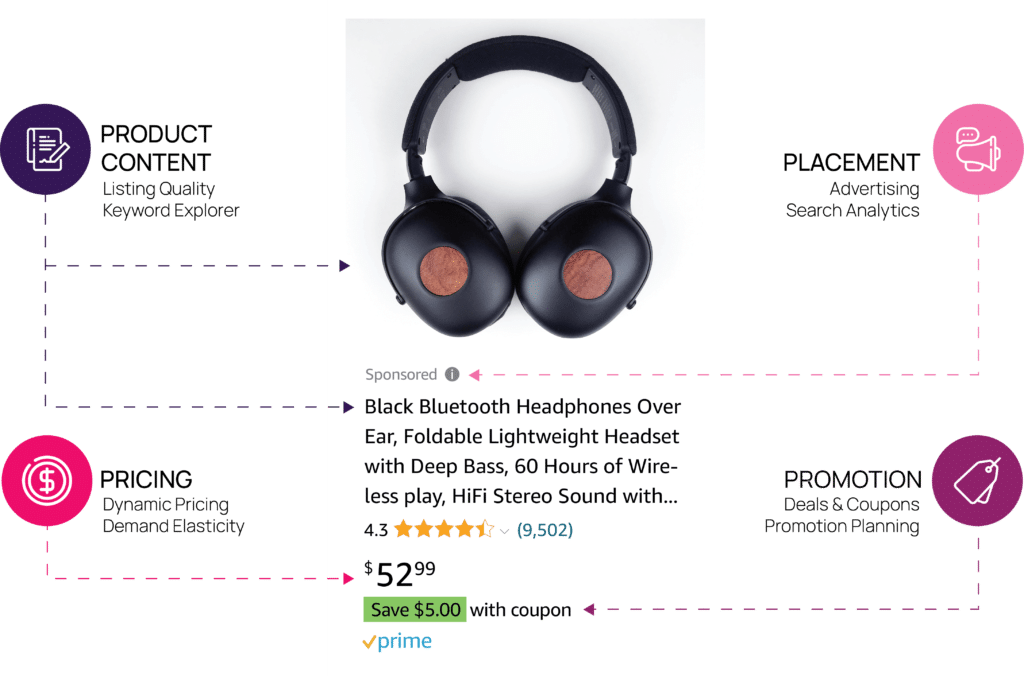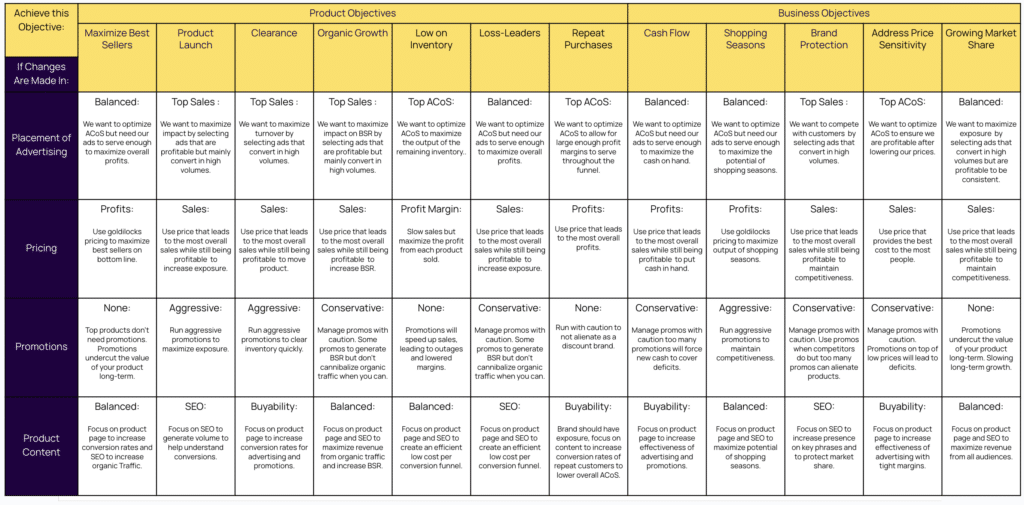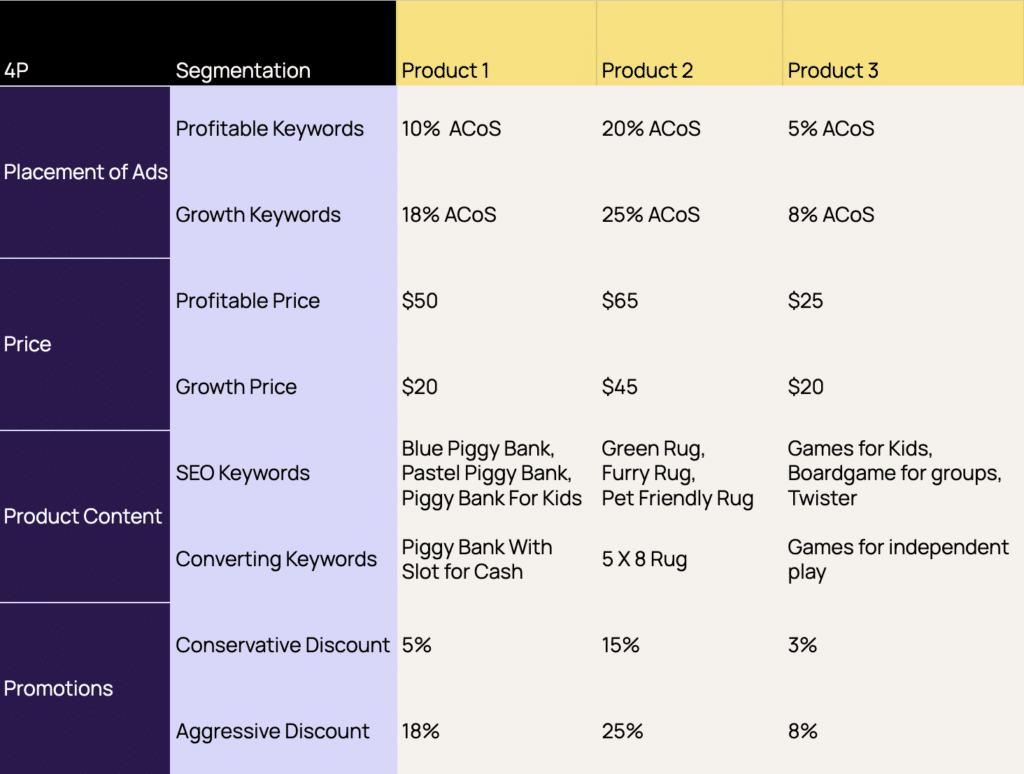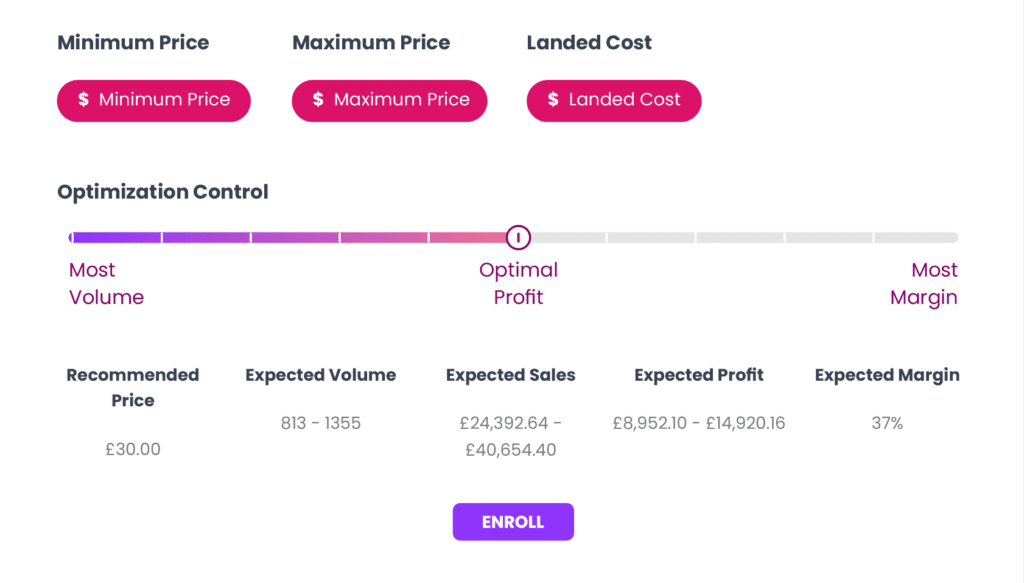When augmenting a process, it’s important to anticipate how to use the new framework, employee, or tactic. Without understanding its application, it becomes the new shiny thing that never reaches its full potential.
As advertising in a silo gets more difficult, one shiny idea marketers are adopting is cohesive merchandising. With the belief that all 4Ps help grow your business, we wrote this blog to ensure that your merchandising strategy doesn’t sit in a drawer with all of the other things you have tried.
How to use the 4Ps

Before we understand what we can do with the 4Ps, it’s important to understand how they’re used.
The 4Ps are a framework for mapping your eCommerce strategy. They denote core elements of merchandising helping you to analyze and action parts of your marketing engine to make specific improvements.
Conceptually, we know that all 4Ps must be present to sell your product but like baking a cake knowing that we’ll need eggs, flour, and sugar does not mean we know how to bake a delicious dessert.
The 4Ps of eCommerce work the same, we know we need advertising, a price, content, and promotions but we also need to know how much of each ingredient we need, and in what combination.
When using the 4Ps there are different magnitudes and settings you can apply. Some types of advertising are good for long-term growth while others help clear inventory.
The same goes for the other 4Ps. For simplicity, we’ve broken them down into 3 segments. Though, you could build an even greater spectrum of settings for your merchandising strategy.

Through iteration, you may find that certain advertising, content, pricing, and promotions are the best way to maximize profits while doing something completely different for a store-wide holiday event.
By establishing KPIs across the 4Ps, you give yourself the freedom to merchandise your products with granularity and scalability.
Using this framework, we combine the 4Ps to illustrate some of the best ways that they can help grow your business.
12 of the best ways to grow with the 4Ps
With your 4Ps of merchandising segmented, you can tackle objectives at a product and business level.

Product Level Objectives
Not every product is a best seller. Some products are new, while others are overstocked.
By identifying each product’s purpose, you can leverage the 4Ps accordingly.
We name some of the most common use cases we see our customers leverage.
1. Grow profits for best sellers
While businesses leverage best sellers to meet a range of objectives, they are often best used to drive profitability.
To help grow best sellers you could:
- Use keywords that have good ACoS with strong sales velocity prioritizing profits over profit margins,
- Use Goldilocks pricing,
- Leverage conservative promotions to maintain or improve BSR during slow periods, and
- Update content to increase landing page conversion rate.
2. Launch new products
Expecting your products to hit the market like the latest iPhone or a Taylor Swift album may set you up for disappointment. Merchandising products takes time on places like Amazon and having your 4Ps segmented in a way that helps build momentum is important.
Products that are launched on places like Amazon often go through a “warming up” phase. This process includes data collection, getting reviews, and improving the products’ BSR.
To help warm up new products, you could:
- Aggressively advertise your products for brand awareness and sales,
- Lower prices to increase overall customer base, BSR, and reviews,
- Run strong promotions with heavy discounts when able to, and
- Focus on content that builds your SEO to get more traffic to your low prices, and strong promotions.
3. Clear inventory by fuelling sales velocity
Holding onto a product can be costly, and promoting products that won’t sell at a regular price helps generate cash flow for other activities.
To increase sales volume and move products you could:
- Aggressively advertise your products,
- Lower prices to increase sales velocity,
- Run high-percentage discounts, and
- Focus on converting content to ensure customers are convinced by the value of the product.
4. Enhance organic growth
Improving best seller rank (BSR) and SEO are two major ways to increase your products’ Total Sales.
To generate more organic sales you could:
- Advertise on popular keywords to grow brand awareness,
- Use Goldilocks pricing to maximize overall profits ensuring a healthy BSR as Amazon takes their cut,
- Promote conservatively to be on deal pages and to increase sales, and
- Update your content for SEO to appeal to audiences.
5. Maximize your limited inventory
Increase profits on your in-demand products while avoiding penalties from Amazon for being out of stock.
To make the most of your limited inventory you could:
- Slow down advertising to the most efficient keywords,
- Raise prices to slow down velocity but to maximize your margin on your remaining products,
- Turn off promotions, and
- Ensure that your content is balanced for SEO opportunities and conversions.
6. Establish loss-leaders
With the objective of long-term growth, you may want to build recall with new customers to grow your customer base. Once you leverage introductory products to acquire new-to-brand customers you have an opportunity to re-engage them with higher value or higher margin products.
To build your new-to-brand customer cohort:
- Advertise to generate sales velocity,
- Find the price that sells the most products by analyzing your profit curves,
- Promote these products conservatively to generate brand recognition without turning into a “discount brand”, and,
- Use SEO content that can attract new users to engage them with your low-barrier-to-entry, introductory products.
7. Strengthen repeat sales
Leverage repeat sellers to grow CLV. They often have good conversion rates as another product has built familiarity with the brand, leading to strong ACoS when advertising these products. For many sellers, this can be an opportunity to cash in on hard work from new-to-brand efforts.
To get more repeat sales you could:
- Advertise conservatively focusing on your most profitable ACoS keywords and display advertising to re-engage old customers,
- Use goldilocks pricing to maximize profitability and to mitigate inefficiency from top-of-funnel products,
- Avoid promotions as they can undermine your brand and you should be looking to maximize profits at this step, and,
- Focus on content that proves the value of your high-value products.
Business level objectives
While the 4Ps help with achieving specific product-level objectives they can also help with larger business-level situations that require adjustments across the whole catalog.
1. Increase cash flow
To stay cash-positive, many organizations will implement lower prices and more aggressive advertising to decrease customers’ hesitancy and increase sales.
Cash flow helps organizations stay secure and can even help when they need to leverage cash to expand.
To merchandise your products for cash flow you can:
- Maintain a balance between expensive keywords and profitable ones, maintaining sales velocity but not losing money in running ads too aggressively,
- Similar to advertising, balance prices to ensure people are buying your products without making sales that barely provide any profit,
- Manage promos with caution; too many promotions will force new cash to cover deficits, and
- Focus on content that proves your product’s value. High conversion rates are important to maximize sales velocity while maintaining reasonable prices.
2. Amplify shopping seasons
During shopping seasons like Prime Day and BFCM customers expect promotions. This often means that consumers will not purchase products without a discount. You can either shut off your ads and promotions entirely or adapt during shopping seasons you can:
- Serve low ACoS ads to limit expenditures on top of promotions,
- Use Goldilocks pricing to maximize the output of shopping seasons especially once promotions are layered on top,
- Run aggressive promotions to maintain competitiveness, and
- Ensure that your SEO is focused on the keywords in highest demand.
3. Activate brand protection
In highly competitive industries or as a category leader you may want to protect your brand for long-term stability.
To ensure the strength of your brand you can:
- Select ads that convert in high volumes and take space from competitors,
- Use pricing that attracts large volumes of customers without racing to the bottom to ensure long-term market share ownership,
- Manage promotions with caution. Use deals when competitors do but avoid frequent use to maintain a high-quality brand image, and
- Focus on SEO to increase presence on key phrases and to protect digital shelves.
4. Address price sensitivity
Under certain economic circumstances, customers may become more sensitive to price and a product’s value.
To address price sensitivity you can:
- Optimize ACoS to ensure you are profitable after lowering prices,
- Lower prices to mitigate hesitancy by appealing to a strong sense of frugality,
- Manage promos with caution. Promotions on top of low prices will lead to deficits, and
- Focus on product page content to increase the effectiveness of advertising among tight margins.
5. Profitably grow market share
One of the most common objectives of established brands, the 4Ps can help merchandise for sustainable growth. Prioritizing sales and market penetration but ensuring that merchandising is self-sufficient through healthy profit margins.
You can profitably grow market share by:
- Selecting ads that convert in high volumes but are profitable enough to be consistent long-term,
- Using prices that lead to the most overall sales while still being profitable to maintain competitiveness,
- Promoting conservatively where it can create sales-lift for your products long-term.
- Focus on the product page and SEO to maximize revenue from audiences at all levels of the funnel.
Best practices to integrate the 4Ps into your business
How can you structure the 4Ps to achieve different objectives with precision?
Setting KPIs for your eCommerce merchandising strategy
As mentioned before, there are different magnitudes to which you can leverage each P. To level-set those metrics create specific KPIs for each 4P based on the underlying metrics.
For example, if an average ACoS of 25% produces a lot of sales a month then this would be your growth metric, while a lower ACoS of 5% might be your profit-based metric.

Having a range of metrics allows you to move towards different objectives. In a scenario where a business wants to increase profitability, you may focus on keywords with the best ACoS.
Pretty simple, right?
Not always, as this can be prohibitive to growing market share which might be a secondary objective. For example, ads may slow down as the keywords with the best ACoS could be a few niche search terms.
This stresses the importance of 4P segmentation; it allows a business to be flexible and approach challenges in different ways rather than using the same keywords, ad types, prices, and promotions for every objective. By creating a range of segmentation and plotting benchmarks along the spectrum, you are setting yourself up to tackle nuanced objectives.
Using an inventory clearance example, an organization may have a timeline to move products. They are looking to make space for a new product but not immediately. In such a case, optimizing for profitability may be too slow but optimizing for turnover would be too fast sacrificing more revenue than necessary.
An organization looking to find a middle ground might use a spectrum to find their goldilocks zone for that specific objective. Selecting product content, promotions, pricing, and advertising that fits this middle ground.

Integrating action into your strategy
By associating 4P metrics to each objective and an objective with each product, you leverage the underlying Ps to stay flexible and effective.
Ultimately, by building an eCommerce merchandising workflow you are able to sell your products with a much more nuanced approach. Instead of selecting a range of keywords and picking the promotions suggested by your marketplaces, use your 4P segmentation to select the right variables to maximize your desired outcome, at a moment’s notice.
Now that you know how to use the 4Ps to merchandise your products, you can build the data sets to effectively start yourself while understanding how our eCommerce Merchandising platform truly saves you time if you don’t want to spend time on the historical and ongoing analysis.
Trellis takes in high-level input from you like max ACoS, minimum price, and desired profit margins to segment the data for you and to support different products accordingly. We have automated product tags built into the system like best sellers, overstock, and low inventory as well as new product workflows to help.
Learn the other ways we ensure our automation properly leverages your merchandising strategy and book a demo below: https://gotrellis.com/book-a-demo/



